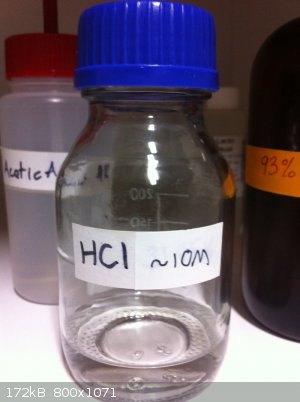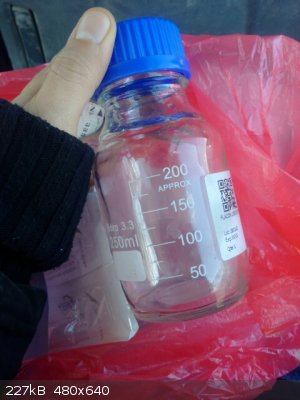thesmug
Hazard to Others
  
Posts: 370
Registered: 17-1-2014
Location: Chicago, Il (USA)
Member Is Offline
Mood: No Mood
|
|
Iodine storage, what happened?
I know you should always make sure your iodine is very secure and I thought mine was until I came back to my reagent cabinet to find every single
bottle label had turned brown/purple. I understand why that happened but what I don't understand is the light white powder covering everything in my
cabinet. My roll of lead foil is also speckled with tiny silver spots across its now white surface. The hinges of my cabinet are also covered in a
thick layer of brown/yellow/green powder which wipes off easily. I also had an old container which I was reusing as a reagent container which is
painted silver and is now covered in tiny transparent crystals. I assume these events are all related but can someone help me in determining if this
is a serious issue. I suppose the silver crystals might be silver iodide but I'm not sure. I have pictures here: http://imgur.com/a/dCXr0
Good eyes
|
|
|
bismuthate
National Hazard
   
Posts: 803
Registered: 28-9-2013
Location: the island of stability
Member Is Offline
Mood: self reacting
|
|
Iodine needs an ampule. That's all that will last.
|
|
|
Oscilllator
National Hazard
   
Posts: 659
Registered: 8-10-2012
Location: The aqueous layer
Member Is Offline
Mood: No Mood
|
|
Are you quite sure that the iodine is the culprit here? I don't see how a badly sealed iodine bottle could cause a white deposit on glass. The fact
that you have a deposit on glass strongly suggests that there was either some kind of spray, or two gasses leaked and then reacted, forming a deposit
(Ammonia and HCl springs to mind).
You could check the corroded parts for iodine with a starch/HCl/H2O2 mixture (I think) which should help narrow down the cause of the problem. If you
are storing HCl anywhere near this corrosion though, I would take a good hard look at your storage, since HCl is notoriously bad for causing
corrosion.
|
|
|
thesmug
Hazard to Others
  
Posts: 370
Registered: 17-1-2014
Location: Chicago, Il (USA)
Member Is Offline
Mood: No Mood
|
|
Ok thanks. I have an HCl bottle but I am very sure it was sealed tightly last time I used it. I'll check again. Thank's for the help.
Good eyes
|
|
|
Texium
Administrator
       
Posts: 4581
Registered: 11-1-2014
Location: Salt Lake City
Member Is Offline
Mood: PhD candidate!
|
|
What kind of bottle is it? HCl is so insidious that it can escape from all but the best of bottles even when they are tightly closed. I keep mine in a
good quality Pyrex reagent bottle. It it doesn't seem like it can escape from that. It easily escapes from the jug that it came in though.

|
|
|
thesmug
Hazard to Others
  
Posts: 370
Registered: 17-1-2014
Location: Chicago, Il (USA)
Member Is Offline
Mood: No Mood
|
|
Yeah it's hardware store brand and still in the original plastic bottle.
Good eyes
|
|
|
Oscilllator
National Hazard
   
Posts: 659
Registered: 8-10-2012
Location: The aqueous layer
Member Is Offline
Mood: No Mood
|
|
If your plastic bottle is a large (1L+) bottle and you have to store it inside, it could well be worth it to store the bottle inside a sealed bucket
with a couple of spoonfuls of Na2CO3 or other cheap base in the bottom to neutralise the inevitable HCl leakage. For day-to-day usage I would
recommend a using small bottle similar to the one zts16 has, and topping it up as necessary. I personally have a 4L bottle of 37% HCl that I store
outside, and a 500ml Worcestershire Sauce bottle that I use in the lab.
|
|
|
careysub
International Hazard
    
Posts: 1339
Registered: 4-8-2014
Location: Coastal Sage Scrub Biome
Member Is Offline
Mood: Lowest quantum state
|
|
I keep my HCl outside also. I keep my ready supply in a plastic squeeze bottle (type A, seen here):
http://www.mcmaster.com/#liquid-projecting-bottles/=tk1fpl
My little jar of iodine I keep in another jar, one with a silicone gasket and a snap down seal (which also has a bit of thiosulfate in the bottom). I
keep that jar in my sock drawer (where there is nothing to rust) in the coolest part of my house. Iron-gray crystals have collected on the underside
of the jar lid.
|
|
|
woelen
Super Administrator
        
Posts: 8014
Registered: 20-8-2005
Location: Netherlands
Member Is Offline
Mood: interested
|
|
HCl in a plastic bottle or jerry can certainly is the problem here. The plastic is slightly porous and HCl fumes can pass through. These fumes make
everything nearby humid and can cause glass and metal to be covered by a white powder. The white powder is formed, because inside a house where people
and animals live there always is a very tiny amount of ammonia and organic amines in the air and these react with the HCl fumes to give white
depositions of (substituted) ammonium chloride.
Get your HCl out of the cabinet, e.g. store it in a garage or shed. Cleanup everything, otherwise you will experience excessive corrosion of hinges
and nearby tools.
I store my HCl in Schott Duran bottles, as shown by zts16, but I use caps with a silicone filled teflon liner. The silicone is soft and makes a very
good seal. In this way I store 30% HCl and I have no white frost at all. I also have a 37% bottle, but even the silicone filled teflon liners do no
prevent escaping of the acid fumes. The silicone filler becomes wet and leaks out of the cap. So, 37% HCl definitely should be stored elsewhere.
Similar storage issues exist for anhydrous AlCl3, NbCl5, PCl3, PCl5, POCl3 and CH3COCl. All of these form HCl in contact with humid air and require
VERY good seals with teflon. HCl is remarkably destructive in the long run, more so than HNO3 and SO3.
|
|
|
DieForelle
Hazard to Self
 
Posts: 61
Registered: 2-2-2012
Location: East Coast
Member Is Offline
Mood: No Mood
|
|
Thank you woelen, you have explained (most excellently btw!) a mystery that his been bothering me for some time. I have a nice amber Wheaton bottle
of diluted 20% HCl that had this white deposit near the top and I've wondered how the heck the gas can be escaping. And why it would even form white
deposits like that. In my case, the cap is only a polyseal.
|
|
|
Fantasma4500
International Hazard
    
Posts: 1681
Registered: 12-12-2012
Location: Dysrope (aka europe)
Member Is Offline
Mood: dangerously practical
|
|
once decided to turn scrap iodide into CuI
so as this reaction formed iodine i let it stand for some time, capped it off with aluminium foil very tightly
and put it in my freezer
nearly shat myself when i saw the insides of my fridge and couldnt help but think ''chemistry'' when i looked at a milk cartons strangely faded outer
carton which was now an undescribable colour
at school they store iodine in a glass bottle in the freezer, but thats a pretty decent lid they got for that stuff, supposing it could be increased
by dipping it upside down in solution of polyvinyl acetate (wooden glue) or nitrocellulose lacquer, perhaps stretching electrical tape and wrapping it
very tightly around bottleneck will work
perhaps store a tiny bottle under oil may work? a lead piece should keep it down
|
|
|
thesmug
Hazard to Others
  
Posts: 370
Registered: 17-1-2014
Location: Chicago, Il (USA)
Member Is Offline
Mood: No Mood
|
|
Ok, I've thrown away the iodine bottle and bought a reagent bottle like shown above. Thanks for the help everyone!
Oh I forgot, does anyone know about those crystals on the silver?
[Edited on 9/3/14 by thesmug]
Good eyes
|
|
|
The Volatile Chemist
International Hazard
    
Posts: 1981
Registered: 22-3-2014
Location: 'Stil' in the lab...
Member Is Offline
Mood: Copious
|
|
Reagent bottles are always pretty. As for volatile compounds, electrical tape has been a favorite of mine, but mostly b/c of it's convenience.
|
|
|
forgottenpassword
Hazard to Others
  
Posts: 374
Registered: 12-12-2013
Member Is Offline
Mood: No Mood
|
|
Absolutely. I use electrical tape on most things. Iodine doesn't escape, conc. HCl doesn't escape, anhydrous things stay anhydrous.
|
|
|
Pyro
International Hazard
    
Posts: 1305
Registered: 6-4-2012
Location: Gent, Belgium
Member Is Offline
Mood: No Mood
|
|
put I2 in a DURAN glass bottle with blue cap. i have had over 100g in there for quite a while with no leakage. if i smell right at the cap (where cap
meets glass), there is the faintest odor of iodne.
all above information is intellectual property of Pyro.  |
|
|
The Volatile Chemist
International Hazard
    
Posts: 1981
Registered: 22-3-2014
Location: 'Stil' in the lab...
Member Is Offline
Mood: Copious
|
|
Electric tape can always be a secondary seal. Acids are always a bit of a 'butt' to store, but worth it of course! (No pun intended  ) )
|
|
|
Fluorite
Hazard to Others
  
Posts: 138
Registered: 26-12-2018
Location: United Arab Emirates
Member Is Offline
|
|
Quote: Originally posted by Texium (zts16)  | What kind of bottle is it? HCl is so insidious that it can escape from all but the best of bottles even when they are tightly closed. I keep mine in a
good quality Pyrex reagent bottle. It it doesn't seem like it can escape from that. It easily escapes from the jug that it came in though.
|
Hey texium I bought a bottle like yours today but I'm not sure why is it borosilicate? not for boiling chemicals in it or anything right?

|
|
|
Tsjerk
International Hazard
    
Posts: 3032
Registered: 20-4-2005
Location: Netherlands
Member Is Offline
Mood: Mood
|
|
It's not made to be a reaction vessel but it is borosilicate. I used them to boil growth medium in and if I was in a hurry I would cool them in cold
water, so they are quite heat shock resistant.
|
|
|
draculic acid69
International Hazard
    
Posts: 1371
Registered: 2-8-2018
Member Is Offline
|
|
Coke bottle works perfectly for 1+yrs now
|
|
|
Belowzero
Hazard to Others
  
Posts: 173
Registered: 6-5-2020
Location: Member Is Offline
Member Is Offline
|
|
For anything that is not perfectly stable I use ziplock bags to store the bottle/container in.
They come cheap and are quite a good indicator for detecting leaks.
|
|
|
Metallophile
Hazard to Self
 
Posts: 87
Registered: 23-3-2018
Member Is Offline
Mood: No Mood
|
|
I've had good luck with these glass vials with Teflon lined caps, that I bought from McMaster-Carr. They weren't cheap, but neither my I2 nor Br2
sample has evaporated at all after several months.
https://www.mcmaster.com/vials/glass-vials/
[Edited on 1/26/2021 by Metallophile]
[Edited on 1/26/2021 by Metallophile]
|
|
|
FrenchChemist
Harmless

Posts: 43
Registered: 25-1-2021
Member Is Offline
|
|
Exactly, in the case of unusual reagents, you should invest in good quality bottles.
In most cases screw cap line from PBT with PTFE coated silicone seal passes the exam
In the only case I was painfully convinced that it is not enough - PCl3 - for this product only an ampoule or a screw cap from TpCh260 (similar to
PFA) with PTFE coated silicone seal.
|
|
|
xxxhibition
Harmless

Posts: 12
Registered: 25-1-2021
Member Is Offline
|
|
Thats right i have tried many Storages Flaskes from Plastik to Glas Bottles also with Teflon Tape etc.... all of them failed.
So i came up to Ampoules no more Problems with Gasing out Iodine.
|
|
|